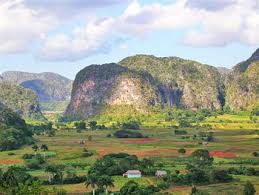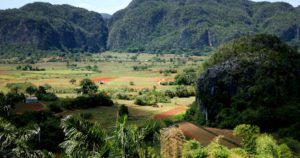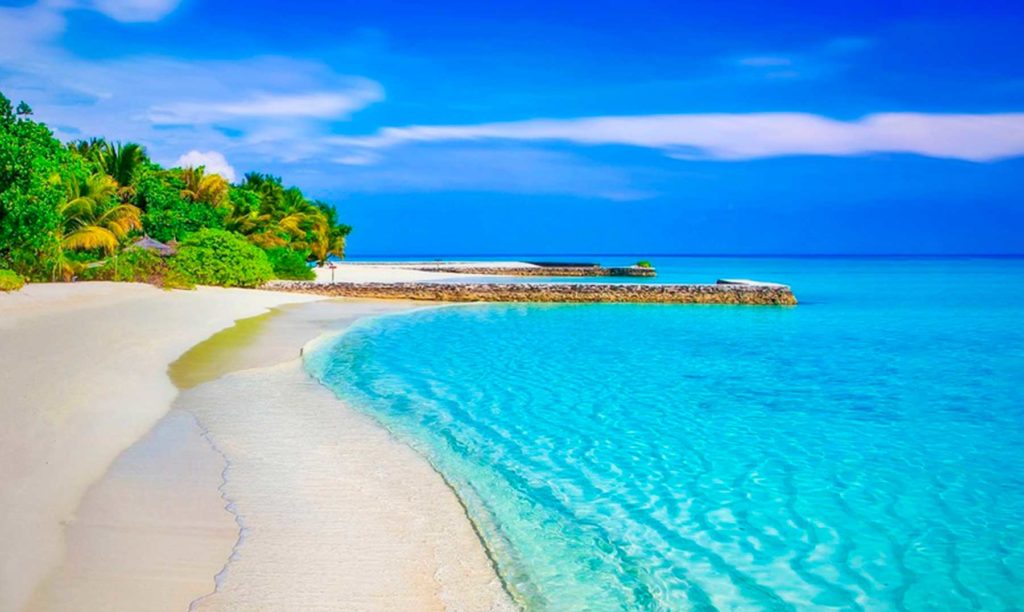 EL VALLE CUBANO DE VIÑALES, UN PAISAJE PATRIMONIO NATURAL DE LA HUMANIDAD.
EL VALLE CUBANO DE VIÑALES, UN PAISAJE PATRIMONIO NATURAL DE LA HUMANIDAD.
El Valle cubano de Viñales es una de las áreas más conocidas y atractivas de Cuba, presenta un escenario excepcional, caracterizado por la fusión de su espectacular belleza natural y la conservación del medio ambiente.
Ubicado en la provincia de Pinar del Río, la zona más occidental de Cuba, en la Sierra de los Órganos, exactamente en el grupo montañoso de la Cordillera de Guaniguanico donde se va disfrutando de la variedad de tonos del verde cubano, cuando se arriba al Valle se percibe un cambio radical y sobrecogedor; la complicidad entre la naturaleza y el silencio hace que el visitante se sienta dueño de una belleza natural majestuosa, que se halla por todas partes.
Los típicos mogotes constituyen formaciones geomorfológicas muy singulares, de gran diversidad de formas, que llegan a medir, en algunos casos, centenares de metros de altura. En el Valle existen otras elevaciones, como Alturas de Pizarras, las cuales están constituidas por una variedad de rocas, las más antiguas existentes a lo largo del país y también en el área caribeña.
También existen en el Valle construcciones con patrones indígenas como la llamada casa de tabaco y el típico bohío cubano que al integrarse a sus valores naturales, mogotes, diferencias del relieve, contraste entre el rojo de los suelos y el verde de los cultivos, conforman un valor estético y socio-cultural excepcional.
En el Valle de Viñales también se pueden encontrar varias cuevas, muy significativas en cuanto a forma y originalidad, como la de “José Miguel” y la del “Indio”. La última es una caverna, que llega a alcanzar los 300 metros de extensión, en cuyo interior corren dos ríos subterráneos.
En la Cueva del Indio, además de las diversas formas y figuras formadas por las estalactitas y estalagmitas, se han encontrado pinturas y restos de los utensilios y entierros de las culturas cubanas precolombinas y que se recorre en bote por el Río San Vicente, que corre por la Cueva.
En el área de Viñales se conocen 47 sitios arqueológicos. De ellos, 19 están vinculados a comunidades aborígenes de la época prehispánica de la Historia de Cuba, donde pueden encontrarse evidencias de sus ritos funerarios, y 28 están relacionados con esclavos cimarrones de origen africano.
El poblado de Viñales, ubicado en el Valle, conserva el tradicional escenario de un asentamiento de agricultores, representado por su calle principal, galerías de columnas a sus lados y casas de tejas, dándole una apariencia singular y agradable.
La magia del Valle de Viñales está en sus mogotes, en los bohíos situados en las laderas de las elevaciones, en un paisaje exclusivo y de singular belleza.
Estas características naturales, combinadas con la rica historia cultural que la región atesora, posibilitaron que el Valle de Viñales fue aprobado en 1999 como Parque Nacional y, en diciembre de ese mismo año, fue declarado por la UNESCO, Patrimonio de la Humanidad, en la categoría de Paisaje Cultural. Posee además la condición de Monumento Nacional, desde el 27 de marzo de 1979.
 THE CUBAN VALLEY OF VIÑALES, A NATURAL HERITAGE LANDSCAPE OF HUMANITY.
THE CUBAN VALLEY OF VIÑALES, A NATURAL HERITAGE LANDSCAPE OF HUMANITY.
The Cuban Viñales Valley is one of the most well-known and attractive areas of Cuba, it presents an exceptional setting, characterized by the fusion of its spectacular natural beauty and the preservation of the environment.
Located in the province of Pinar del Río, the westernmost area of Cuba, in the Sierra de Los Órganos, exactly in the mountainous group of the Cordillera de Guaniguanico where you can enjoy the variety of shades of Cuban green when you arrive at the Valle perceives a radical and overwhelming change; the complicity between nature and silence makes the visitor feel the owner of a majestic natural beauty, which is found everywhere.
The typical mogotes are very unique geomorphological formations, with a great diversity of shapes, which can measure, in some cases, hundreds of meters in height. In the Valley, there are other elevations, such as Alturas de Pizarras, which are made up of a variety of rocks, the oldest existing throughout the country, and also in the Caribbean area.
There are also constructions in the Valley with indigenous patterns such as the so-called tobacco house and the typical Cuban bohío that, when integrated into its natural values, mogotes, relief differences, the contrast between the red of the soil and the green of the crops, make up an exceptional aesthetic and socio-cultural value.
In the Viñales Valley, you can also find several caves, very significant in terms of form and originality, such as “José Miguel” and “Indio”. The last one is a cavern, which reaches 300 meters in length, inside which two underground rivers run.
In the Cueva del Indio, in addition to the various forms and figures formed by stalactites and stalagmites, paintings and remains of utensils and burials of pre-Columbian Cuban cultures have been found and are traveled by boat on the San Vicente River, which runs through the Cave.
In the Viñales area, 47 archaeological sites are known. Of these, 19 are linked to aboriginal communities from the pre-Hispanic era of Cuban History, where evidence of their funeral rites can be found, and 28 are related to maroon slaves of African origin.
The town of Viñales, located in the Valley, preserves the traditional setting of a farmers’ settlement, represented by its main street, column galleries on its sides, and tile houses, giving it a unique and pleasant appearance.
The magic of the Viñales Valley is in its mogotes, in the huts located on the slopes of the elevations, in an exclusive landscape of singular beauty.
These natural features, combined with the rich cultural history that the region treasures, made it possible for the Viñales Valley to be approved in 1999 as a National Park, and, in December of that same year, it was declared a World Heritage Site by UNESCO in the Cultural Landscape category. It also has the status of a National Monument, since March 27, 1979.
Agencies/ RHC/ José Correa/ Internet Photos/ Arnoldo Varona/ www.TheCubanHistory.com
THE CUBAN HISTORY, HOLLYWOOD.










